
CHAUMONT CASTLE
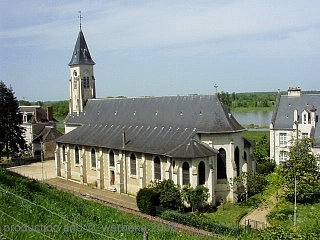 |
Chaumont Castle is built on a hill. When you start climbing from the village Chaumont-sur-Loire, you get first a nice view over the local church, with the Loire in the background.
During the ascent one has much time to collect some thoughts about the history of the castle. We have to move back over a thousand years, to come to the beginning of the downhanded history. Already in the 10th century Eudes I, Count of Blois, built a tower here, in a very strategic place, because he fought hot battles against Foulques Nerra, Count of Anjou, in order to control the valley of the Loire. |
A Norman liege, named Gelduin, served well even under son Eudes II and got finally the castle as a gift. But his own son didn't have any children and consigned the heritage to his sister, who was married to a certain d'Amboise. In the 14th century Peter I d'Amboise and some other nobles tried a rebellion against the king Louis XI. The ruler let set fire onto Chaumont and tear it down afterwards. The area belonging to the castle he confiscated.
But later he forgave Peter and even helped him to rebuild the castle. Through this the Royal family had won faithful subjects for quite some generations ahead. George, the youngest son of Peter's 17 children not only became cardinal and legate for the pope, but also a personal friend of Louis XII and his prime minister. In 1503 the King even came to visit Chaumont - with his entire court. The male line died out during the Italian Wars. The ladies of the house kept the property until 1550, when Catharina de Medici bought it for the amount of 120.000 Francs. |
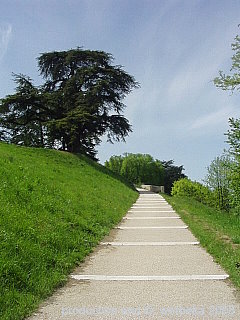
The climb uphill is not very steep,
but rather long |
| This lady doesn't have a very good reputation. She is accused to be a schemer and to be very selfish. But let us have a short look at her situation: She was married to King Henry II, a marriage, which Henry's father, Francis I had made up in Italy. This alliance should strenghthen the bond between France and the Pope. Catherina had become a full orphant only three weeks after her birth und was under the custodianship of Pope Leo X, her granduncle. When Catherina came to France, she soon noticed that her husband was under the spell of a 20 years older mistress, Diana de Poitiers. That went so far, that Henry fathered a bastard girl in Italy, which he called Diana. Besides he had in his emblem an H and a D. One could, of course, read that as "Henri Deux" (Henry the Second), but it was, suitably enough, the initial of his mistress. Whereas the affair to start with still was kept on a discreet level, both lived it out openly later. These were the conditions that the 14 year old girl had to look forward to. Futhermore the nobility looked down at her, because she "only" was a child of a merchant's family. |
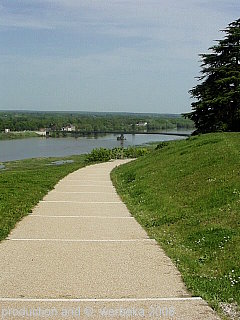
And when you have come around the turn,
it continues in the same way |
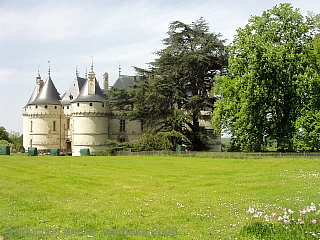
Finally we reach the top
and get to see the castle |
And finally she was a foreigner and was treated with suspiciousness by ordinary people. Under these circumstances it might be necessary with one or the other intrigue, just to make it possible to survive without going crazy. But it definitely shows some intelligence.
After Henry II was killed in a tournament, only 40 years of age, three of her sons became king - that are Francis II, Charles IX and Henry III. Without doubt Catherina interfered in French politics through her boys. But she could also take revenge on Diana of Poitiers. She offered the earlier competitor an exchange: Chaumont against Chenonceau, which Diana had got as a gift from Henry II. Now Catherina had the saying and the former mistress was forced to accept ... |
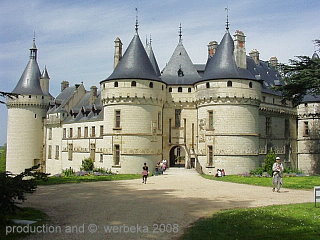
Powerfully the castles dominates the view |
Mean and scheming? After a life full of humiliation?
Together with Diana we come back to the history of the castle. Defiantly she had her emblem positioned at several places of the castle, but she rarely stayed in Chaumont and died seven years later. Afterwards the castle was in the hands of a couple of owners, about whom there is nothing to say, besides Jacques-Donatien Le Ray, who had bought the castle in the 17th century. He had the entire Northern wing torn down, in order to open up the castle to the valley of the Loire. Naturally the inner yard became much lighter and outgoing through this. |
| But at the same time the Northern wing was the oldest part of the castle, together with the Western wing ... For the tearing down of the Northern Wing Nicholas Bertin de Vauguyen often gets the credit, but that must be an error, as there are documents showing, that the wing still was untouched, when de Vauguyen already was dead.
In the middle of the 18th century Le Ray, who was a forest superintendant from Nantes, opened a glassblowing and a ceramics workshop in the side buildings of the castle, in order to provide new jobs. But at the same time he created a basis for artists, who could carry out their ideas here. So was e.g. the English glassblower Robert Scott Godfrey active here and the Italian J.B. Nini, an excellent craftsman of coin making. He left behind about a hundred portraits of more or less known persons on master coins. Among them there was Benjamin Franklin, who was his friend and who lived in France for nine years. |
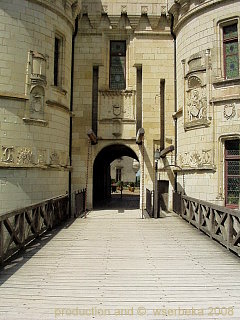
The drawbridge is even now in daily use |
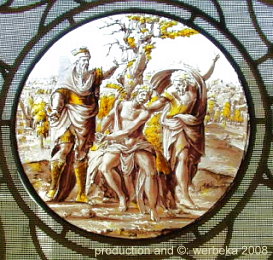 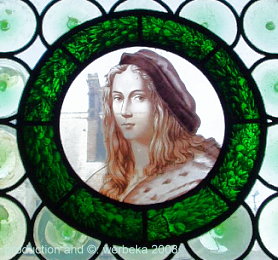
The art of glassproduction has traditional roots in Chaumont
Already before the years of revolution Le Ray had transferred the property to his son, who nowadays was US-citizen (Le Ray had supported the American liberation movement). In that way he could get the property through the crisis almost unharmed, even if he himself continued to live there. The son, with the same name as his father, had in the meantime founded the city of Chaumont in Ohio in the US. He came very seldom to France after the death of his father in 1803.
In 1810 there was another very illustrious guest visiting the castle, the writer Madame (Germaine) de Staël, because she had become banned from Paris after some harsh criticism of Napoleon. For half a year Chaumont now became a literary center and one for the opposition against Napoleon.
After renewed changes of owners the castle became property of Vicomte Joseph Walsh, who was responsible for quite some renovations. |
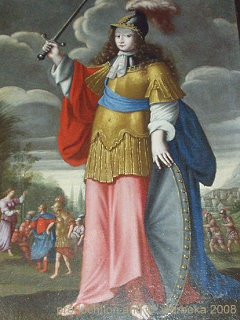
A - rather stylized - picture of Jeanne d'Arc |
| He let build the small towers as a termination of the Western wing and he let repair the drawbridge. But the costs grew bigger than his economy and he was forced to sell the castle again. In 1875 Marie-Charlotte-Constance Say bought it and soon thereafter married Prince Amédée de Broglie. Together they renovated the entire castle, which took about 25 years. But in 1917 Prince Amédée died and when Madame remarried it was more important to her new husband to show off as a bon vivant, than to keep the estate together. Bit after bit almost 2500 ha were sold off and in 1938 even the castle itself was sold to the state.
Apart from the wall hangings, which were former possessings of the Broglies, the furnishing of the rooms is not very mentionable, even if the state nowadays tries to recover as much as possible. Shortly after the takeover of the castle the state had sold all the furniture, and is today trying to refurnish the rooms with pieces from older times, be it by purchases or by means of loans from museums. |
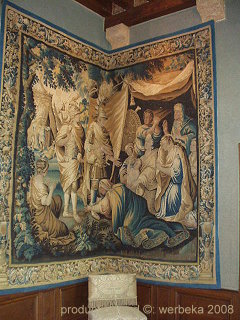
The family of King Darius begs
Alexander the Great for mercy |
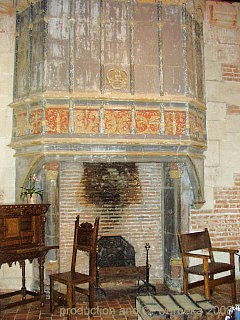
Ruggieri's room |
The fireplace in the room of Ruggieri seems to become renovated right now, but it is still interesting, because of the emblem of Diana de Poitiers - a delta with three interlaced circles. Ruggieri was the astrologer of Catharina de Medici - but it is not really sure, that this was the room where he was living.
The windows in the chapel are from 1888 and the pictures remind of the building of the castle. |
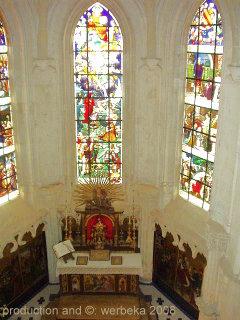
A view into the chapel of the castle |
On the image there is a view of the chapel, seen from the gallery. The owners of the castle had here their own entrance, so that they could take part of the service from here.
Chaumont isn't really one of the most famous castles on the Loire, but it is definitely worth a visit, not at least because of its outer looks.
© Bernhard Kauntz, Västerås 2008
Back to  or to the or to the  of of 
last update: 28.10.2008 by webmaster@werbeka.com
|














